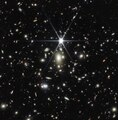Galaxy_cluster_WHL0137-08_(sunrisearc1).jpg

Size of this preview:
590 × 600 pixels
.
Other resolutions:
236 × 240 pixels
|
472 × 480 pixels
|
756 × 768 pixels
|
1,008 × 1,024 pixels
|
2,015 × 2,048 pixels
|
6,507 × 6,612 pixels
.
Summary
| Description Galaxy cluster WHL0137-08 (sunrisearc1).jpg |
English:
This image from the NASA/ESA/CSA James Webb Space Telescope of a massive galaxy cluster called WHL0137-08 contains the most strongly magnified galaxy known in the Universe’s first billion years: the Sunrise Arc, and within that galaxy, the most distant star ever detected.The star, nicknamed Earendel, was
first discovered
by the NASA/ESA Hubble Space Telescope. Follow-up observations using Webb’s NIRCam (
Near-Infrared Camera
) reveals the star to be a massive B-type star more than twice as hot as our Sun, and about a million times more luminous.Earendel is positioned along a ripple in spacetime that gives it extreme magnification, allowing it to emerge into view from its host galaxy, which appears as a red smear across the sky. The star is detectable only due to the combined power of human technology and nature via an effect called
gravitational lensing
.While other features in the galaxy appear multiple times due to the gravitational lensing, Earendel only appears as a single point of light even in Webb’s high-resolution infrared imaging. Based on this, astronomers determine the star is magnified by a factor of at least 4000, and thus Earendel is extremely small – the most distant stellar source ever detected.
The previous record-holder
for the most distant star was detected by Hubble around 4 billion years after the Big Bang.In this image, the Sunrise Arc appears just below the diffraction spike at the 5 o’clock position. The fuzzier, white galaxies at the centre of the image are part of the galaxy cluster bound together by gravity. The various redder, curved galaxies are background galaxies picked up by Webb’s sensitive mirror.Webb’s NIRCam also shows other remarkable details in the Sunrise Arc. Features include both young star-forming regions and older established star clusters. On either side of the wrinkle of maximum magnification, which runs right through Earendel, these features are mirrored by the distortion of the gravitational lens. The region forming stars appears elongated, and is estimated to be less than 5 million years old. Smaller dots on either side of Earendel are two images of one older, more established star cluster, estimated to be 10 million years or older. Astronomers determined this star cluster is gravitationally bound and likely to persist until the present day. This shows us how the globular clusters in our own Milky Way might have looked when they formed 13 billion years ago.Astronomers are currently analysing data from Webb’s NIRSpec (
Near-Infrared Spectrograph
) instrument observations of the Sunrise Arc galaxy and Earendel, which will provide precise composition and distance measurements for the galaxy.Since
Hubble’s discovery of Earendel
, Webb has detected other very distant stars using this technique, though none quite as far as Earendel. The discoveries have opened a new realm of the Universe to stellar physics, and new subject matter to scientists studying the early Universe, where once galaxies were the smallest detectable cosmic objects. There is cautious hope that this could be a step toward the eventual detection of one of the very first generation of stars, composed only of the raw ingredients of the Universe created in the big bang – hydrogen and helium.[
Image description
: A black background is scattered with hundreds of small galaxies of different shapes, ranging in colour from white to yellow to red. Some galaxies, mostly the redder galaxies, are distorted, appearing to be stretched out or mirror imaged. Just a little bit above the centre, there is a bright source of light, a star, with 8 bright diffraction spikes extending out from it. Below the star are several noticeably fuzzy white galaxies that resemble cotton balls – these are part of a galaxy cluster. To the lower right of the star is a particularly long, red, thin line stretching from one o’clock to 7 o’clock.]
|
| Date | 9 August 2023 (upload date) |
| Source | Galaxy cluster WHL0137-08 |
| Author | NASA, ESA, CSA, D. Coe (AURA/STScI for ESA), Z. Levay |
| Other versions |
|
Licensing
|
|
ESA/Webb images, videos and web texts are released by the
ESA
under the
Creative Commons Attribution 4.0 International license
and may on a non-exclusive basis be reproduced without fee provided they are clearly and visibly credited. Detailed conditions are below; see the
ESA copyright statement
for full information.
For images created by NASA or on the webbtelescope.org website, use the
{{PD-Webb}}
tag.
Conditions
:
Notes :
|

|
This file is licensed under the
Creative Commons
Attribution 4.0 International
license.
Attribution:
NASA, ESA, CSA, D. Coe (AURA/STScI for ESA), Z. Levay
-
You are free:
- to share – to copy, distribute and transmit the work
- to remix – to adapt the work
-
Under the following conditions:
- attribution – You must give appropriate credit, provide a link to the license, and indicate if changes were made. You may do so in any reasonable manner, but not in any way that suggests the licensor endorses you or your use.
Captions
Add a one-line explanation of what this file represents


